IT Management Issues Report: Analysis of MonetGroup's IT Strategies
VerifiedAdded on 2020/04/07
|9
|2430
|79
Report
AI Summary
This report critically examines the IT management issues faced by MonetGroup, a group of holiday resorts. The report focuses on two key decisions: the implementation of a customer loyalty scheme (MonetLoyalty) and the introduction of interactive tools for customer engagement. It evaluates the effectiveness of these initiatives, particularly concerning internet marketing and the application of IT within the tourism industry. The analysis explores the significance of information systems, IT infrastructure, and the impact of the internet on customer behavior, including online booking and price comparison. The report also discusses the importance of direct marketing, vertical integration, and the creation of online communities. Recommendations are provided to enhance MonetGroup's brand development through e-commerce, emphasizing the use of customer data, personalized offers, and online security to improve the customer experience and drive business success. The report concludes with a discussion on the evolving role of IT in tourism, including the importance of customer reviews and online platforms for comparison and booking.
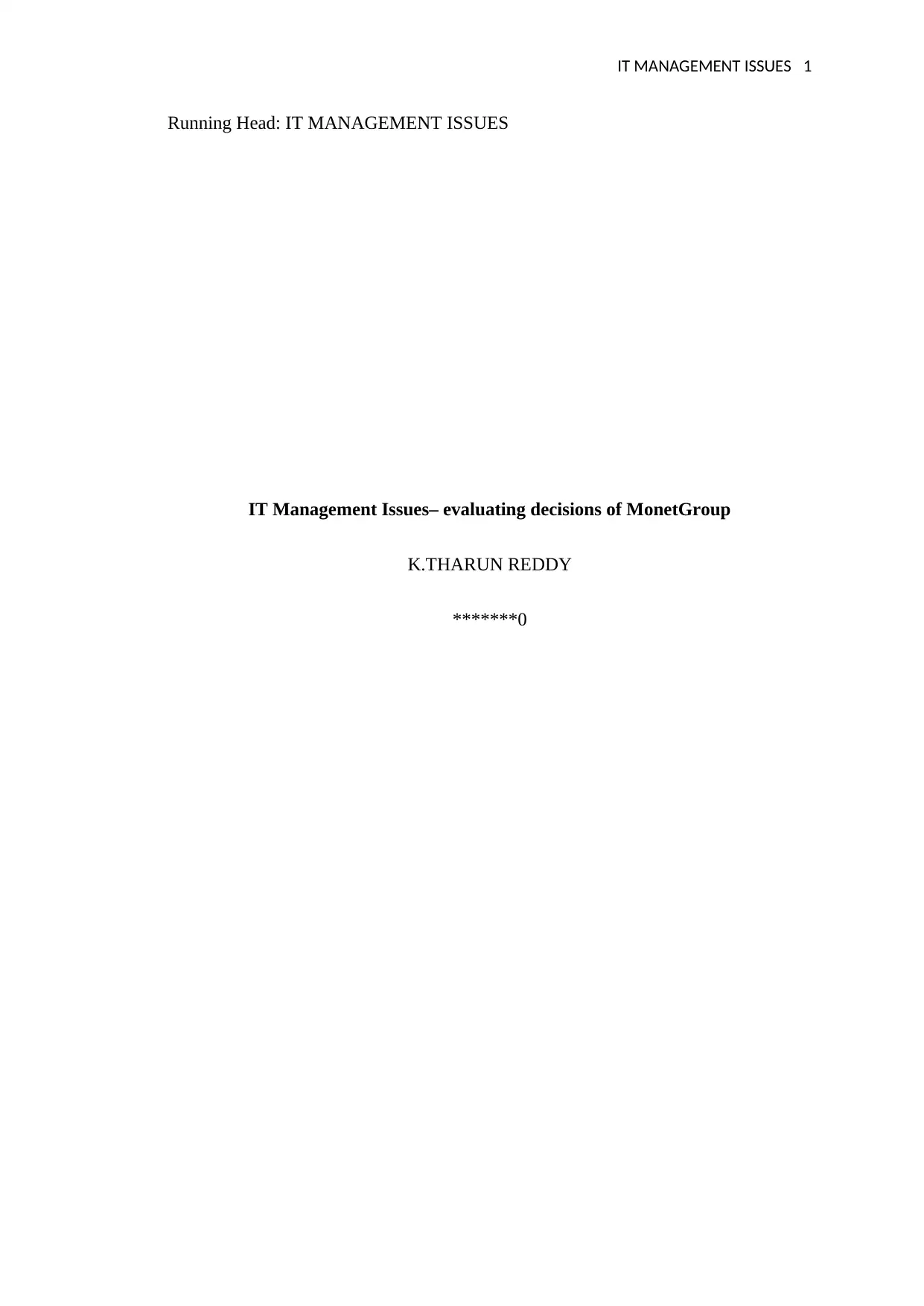
IT MANAGEMENT ISSUES 1
Running Head: IT MANAGEMENT ISSUES
IT Management Issues– evaluating decisions of MonetGroup
K.THARUN REDDY
*******0
Running Head: IT MANAGEMENT ISSUES
IT Management Issues– evaluating decisions of MonetGroup
K.THARUN REDDY
*******0
Paraphrase This Document
Need a fresh take? Get an instant paraphrase of this document with our AI Paraphraser
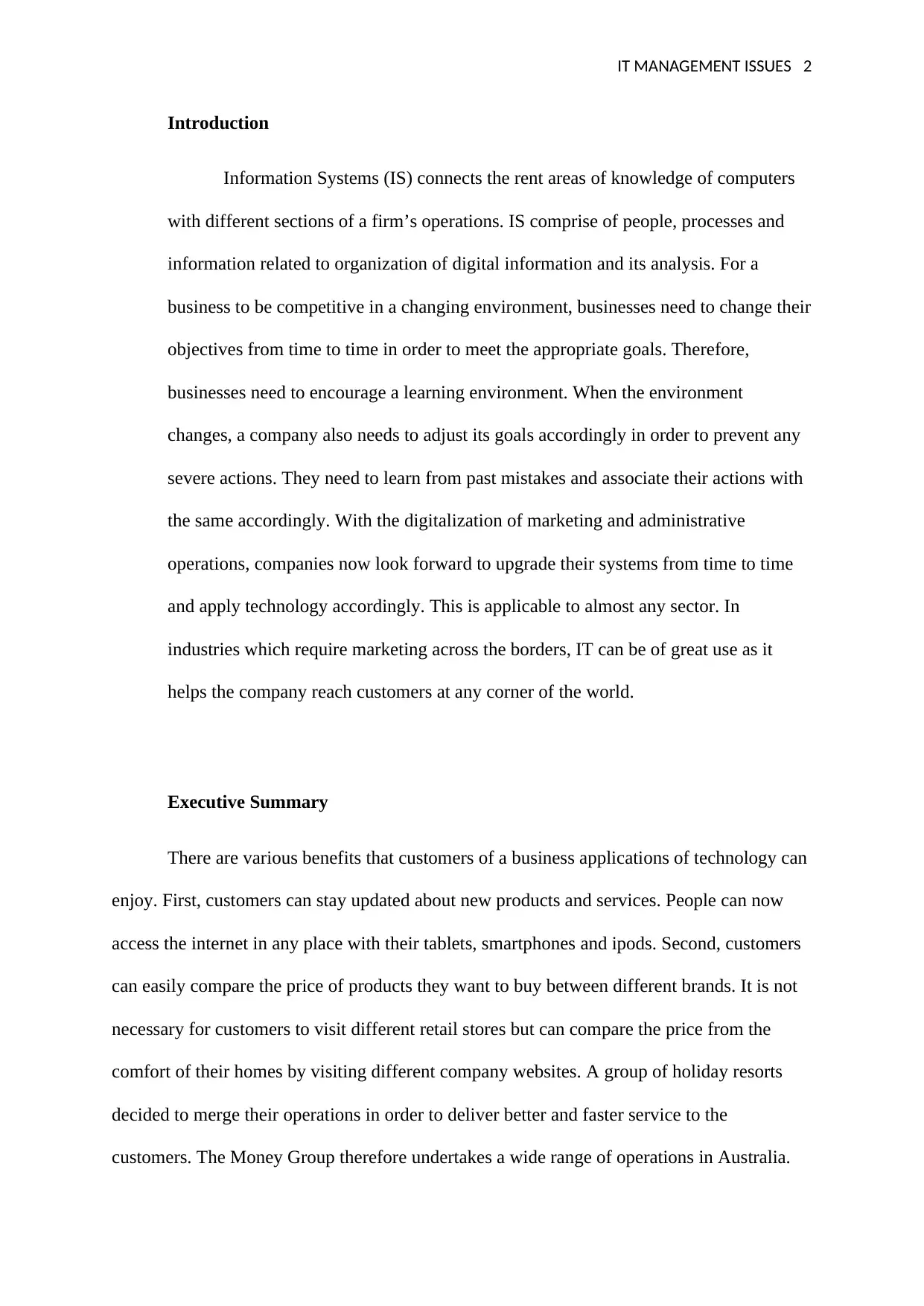
IT MANAGEMENT ISSUES 2
Introduction
Information Systems (IS) connects the rent areas of knowledge of computers
with different sections of a firm’s operations. IS comprise of people, processes and
information related to organization of digital information and its analysis. For a
business to be competitive in a changing environment, businesses need to change their
objectives from time to time in order to meet the appropriate goals. Therefore,
businesses need to encourage a learning environment. When the environment
changes, a company also needs to adjust its goals accordingly in order to prevent any
severe actions. They need to learn from past mistakes and associate their actions with
the same accordingly. With the digitalization of marketing and administrative
operations, companies now look forward to upgrade their systems from time to time
and apply technology accordingly. This is applicable to almost any sector. In
industries which require marketing across the borders, IT can be of great use as it
helps the company reach customers at any corner of the world.
Executive Summary
There are various benefits that customers of a business applications of technology can
enjoy. First, customers can stay updated about new products and services. People can now
access the internet in any place with their tablets, smartphones and ipods. Second, customers
can easily compare the price of products they want to buy between different brands. It is not
necessary for customers to visit different retail stores but can compare the price from the
comfort of their homes by visiting different company websites. A group of holiday resorts
decided to merge their operations in order to deliver better and faster service to the
customers. The Money Group therefore undertakes a wide range of operations in Australia.
Introduction
Information Systems (IS) connects the rent areas of knowledge of computers
with different sections of a firm’s operations. IS comprise of people, processes and
information related to organization of digital information and its analysis. For a
business to be competitive in a changing environment, businesses need to change their
objectives from time to time in order to meet the appropriate goals. Therefore,
businesses need to encourage a learning environment. When the environment
changes, a company also needs to adjust its goals accordingly in order to prevent any
severe actions. They need to learn from past mistakes and associate their actions with
the same accordingly. With the digitalization of marketing and administrative
operations, companies now look forward to upgrade their systems from time to time
and apply technology accordingly. This is applicable to almost any sector. In
industries which require marketing across the borders, IT can be of great use as it
helps the company reach customers at any corner of the world.
Executive Summary
There are various benefits that customers of a business applications of technology can
enjoy. First, customers can stay updated about new products and services. People can now
access the internet in any place with their tablets, smartphones and ipods. Second, customers
can easily compare the price of products they want to buy between different brands. It is not
necessary for customers to visit different retail stores but can compare the price from the
comfort of their homes by visiting different company websites. A group of holiday resorts
decided to merge their operations in order to deliver better and faster service to the
customers. The Money Group therefore undertakes a wide range of operations in Australia.
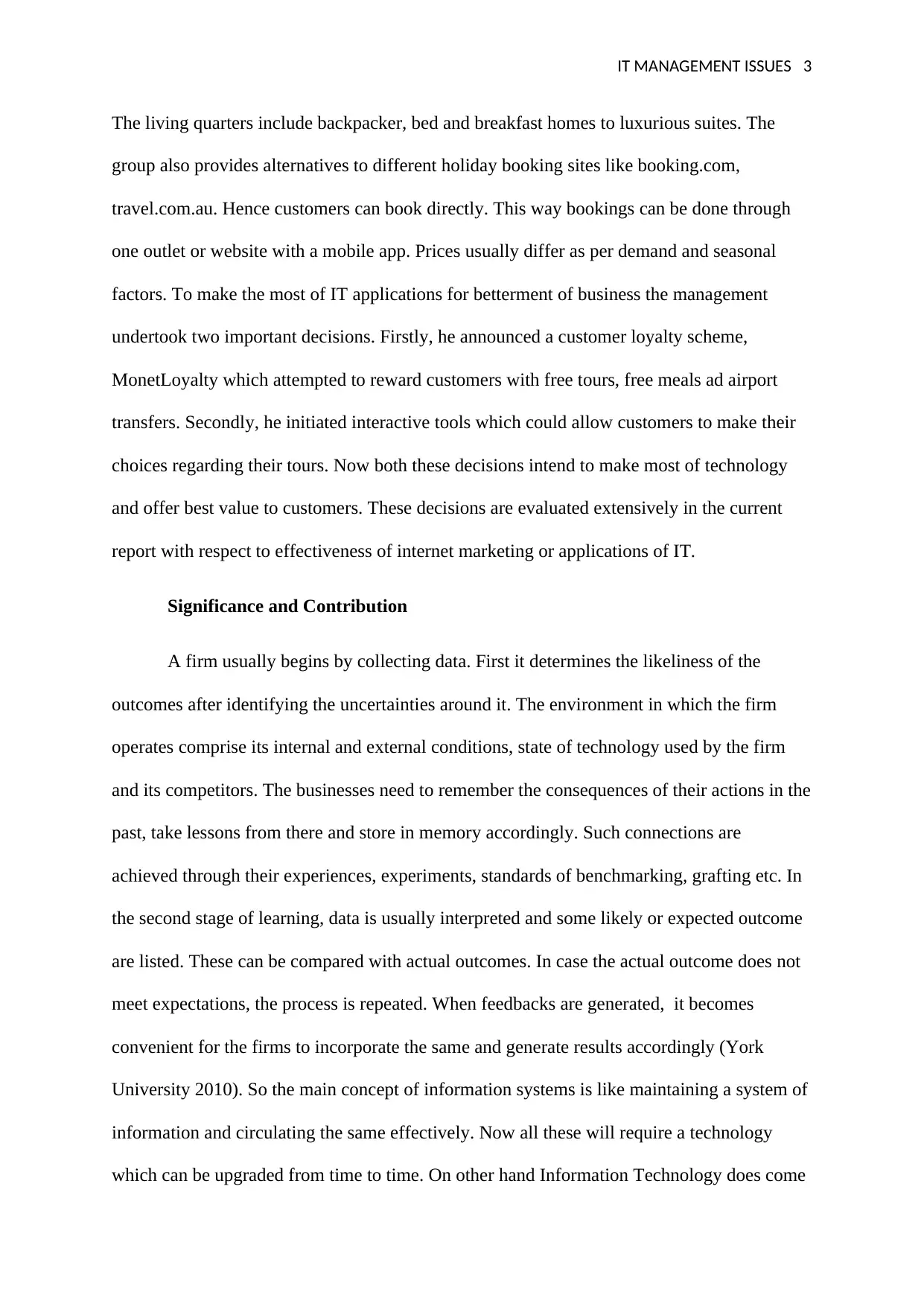
IT MANAGEMENT ISSUES 3
The living quarters include backpacker, bed and breakfast homes to luxurious suites. The
group also provides alternatives to different holiday booking sites like booking.com,
travel.com.au. Hence customers can book directly. This way bookings can be done through
one outlet or website with a mobile app. Prices usually differ as per demand and seasonal
factors. To make the most of IT applications for betterment of business the management
undertook two important decisions. Firstly, he announced a customer loyalty scheme,
MonetLoyalty which attempted to reward customers with free tours, free meals ad airport
transfers. Secondly, he initiated interactive tools which could allow customers to make their
choices regarding their tours. Now both these decisions intend to make most of technology
and offer best value to customers. These decisions are evaluated extensively in the current
report with respect to effectiveness of internet marketing or applications of IT.
Significance and Contribution
A firm usually begins by collecting data. First it determines the likeliness of the
outcomes after identifying the uncertainties around it. The environment in which the firm
operates comprise its internal and external conditions, state of technology used by the firm
and its competitors. The businesses need to remember the consequences of their actions in the
past, take lessons from there and store in memory accordingly. Such connections are
achieved through their experiences, experiments, standards of benchmarking, grafting etc. In
the second stage of learning, data is usually interpreted and some likely or expected outcome
are listed. These can be compared with actual outcomes. In case the actual outcome does not
meet expectations, the process is repeated. When feedbacks are generated, it becomes
convenient for the firms to incorporate the same and generate results accordingly (York
University 2010). So the main concept of information systems is like maintaining a system of
information and circulating the same effectively. Now all these will require a technology
which can be upgraded from time to time. On other hand Information Technology does come
The living quarters include backpacker, bed and breakfast homes to luxurious suites. The
group also provides alternatives to different holiday booking sites like booking.com,
travel.com.au. Hence customers can book directly. This way bookings can be done through
one outlet or website with a mobile app. Prices usually differ as per demand and seasonal
factors. To make the most of IT applications for betterment of business the management
undertook two important decisions. Firstly, he announced a customer loyalty scheme,
MonetLoyalty which attempted to reward customers with free tours, free meals ad airport
transfers. Secondly, he initiated interactive tools which could allow customers to make their
choices regarding their tours. Now both these decisions intend to make most of technology
and offer best value to customers. These decisions are evaluated extensively in the current
report with respect to effectiveness of internet marketing or applications of IT.
Significance and Contribution
A firm usually begins by collecting data. First it determines the likeliness of the
outcomes after identifying the uncertainties around it. The environment in which the firm
operates comprise its internal and external conditions, state of technology used by the firm
and its competitors. The businesses need to remember the consequences of their actions in the
past, take lessons from there and store in memory accordingly. Such connections are
achieved through their experiences, experiments, standards of benchmarking, grafting etc. In
the second stage of learning, data is usually interpreted and some likely or expected outcome
are listed. These can be compared with actual outcomes. In case the actual outcome does not
meet expectations, the process is repeated. When feedbacks are generated, it becomes
convenient for the firms to incorporate the same and generate results accordingly (York
University 2010). So the main concept of information systems is like maintaining a system of
information and circulating the same effectively. Now all these will require a technology
which can be upgraded from time to time. On other hand Information Technology does come
⊘ This is a preview!⊘
Do you want full access?
Subscribe today to unlock all pages.

Trusted by 1+ million students worldwide
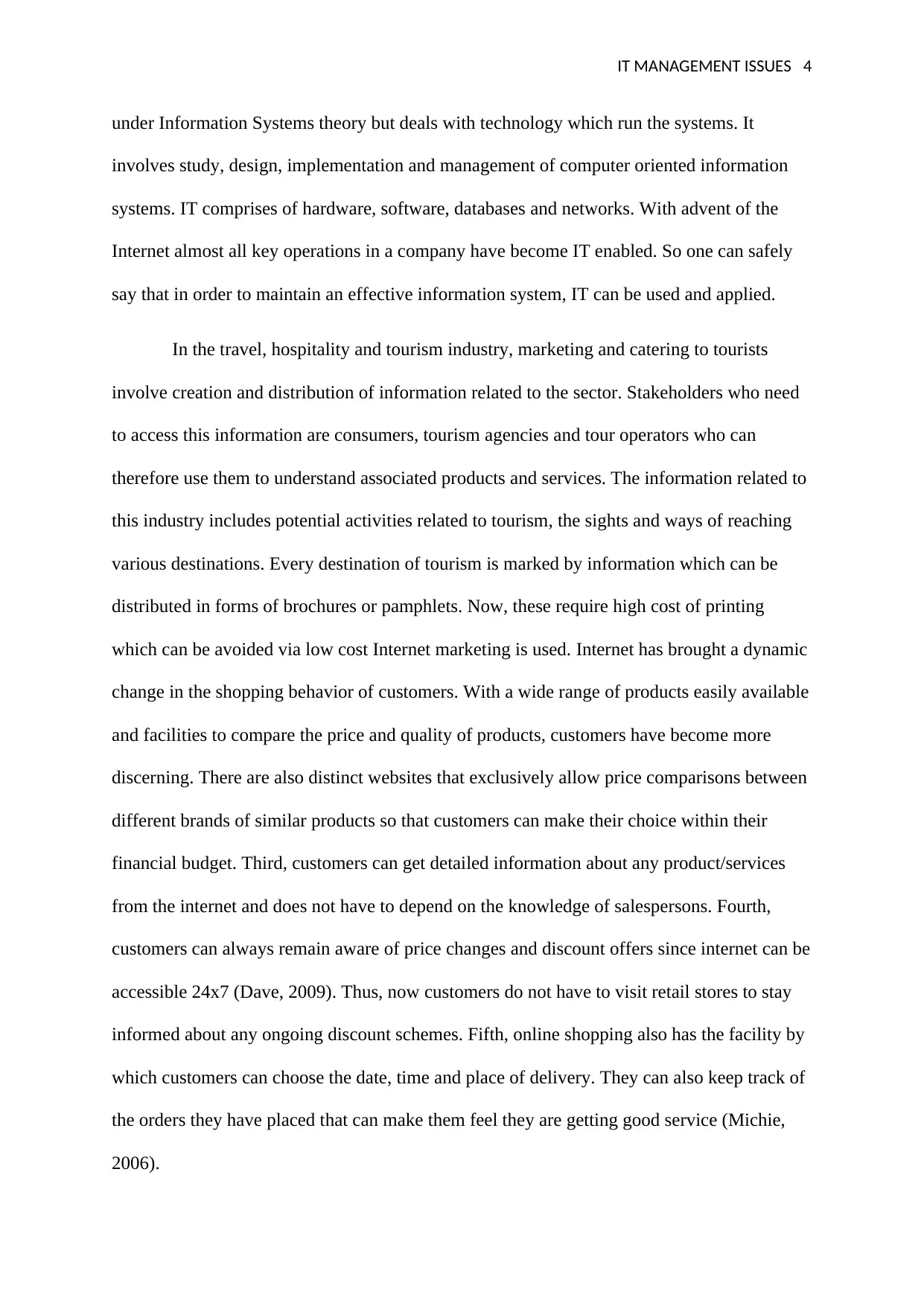
IT MANAGEMENT ISSUES 4
under Information Systems theory but deals with technology which run the systems. It
involves study, design, implementation and management of computer oriented information
systems. IT comprises of hardware, software, databases and networks. With advent of the
Internet almost all key operations in a company have become IT enabled. So one can safely
say that in order to maintain an effective information system, IT can be used and applied.
In the travel, hospitality and tourism industry, marketing and catering to tourists
involve creation and distribution of information related to the sector. Stakeholders who need
to access this information are consumers, tourism agencies and tour operators who can
therefore use them to understand associated products and services. The information related to
this industry includes potential activities related to tourism, the sights and ways of reaching
various destinations. Every destination of tourism is marked by information which can be
distributed in forms of brochures or pamphlets. Now, these require high cost of printing
which can be avoided via low cost Internet marketing is used. Internet has brought a dynamic
change in the shopping behavior of customers. With a wide range of products easily available
and facilities to compare the price and quality of products, customers have become more
discerning. There are also distinct websites that exclusively allow price comparisons between
different brands of similar products so that customers can make their choice within their
financial budget. Third, customers can get detailed information about any product/services
from the internet and does not have to depend on the knowledge of salespersons. Fourth,
customers can always remain aware of price changes and discount offers since internet can be
accessible 24x7 (Dave, 2009). Thus, now customers do not have to visit retail stores to stay
informed about any ongoing discount schemes. Fifth, online shopping also has the facility by
which customers can choose the date, time and place of delivery. They can also keep track of
the orders they have placed that can make them feel they are getting good service (Michie,
2006).
under Information Systems theory but deals with technology which run the systems. It
involves study, design, implementation and management of computer oriented information
systems. IT comprises of hardware, software, databases and networks. With advent of the
Internet almost all key operations in a company have become IT enabled. So one can safely
say that in order to maintain an effective information system, IT can be used and applied.
In the travel, hospitality and tourism industry, marketing and catering to tourists
involve creation and distribution of information related to the sector. Stakeholders who need
to access this information are consumers, tourism agencies and tour operators who can
therefore use them to understand associated products and services. The information related to
this industry includes potential activities related to tourism, the sights and ways of reaching
various destinations. Every destination of tourism is marked by information which can be
distributed in forms of brochures or pamphlets. Now, these require high cost of printing
which can be avoided via low cost Internet marketing is used. Internet has brought a dynamic
change in the shopping behavior of customers. With a wide range of products easily available
and facilities to compare the price and quality of products, customers have become more
discerning. There are also distinct websites that exclusively allow price comparisons between
different brands of similar products so that customers can make their choice within their
financial budget. Third, customers can get detailed information about any product/services
from the internet and does not have to depend on the knowledge of salespersons. Fourth,
customers can always remain aware of price changes and discount offers since internet can be
accessible 24x7 (Dave, 2009). Thus, now customers do not have to visit retail stores to stay
informed about any ongoing discount schemes. Fifth, online shopping also has the facility by
which customers can choose the date, time and place of delivery. They can also keep track of
the orders they have placed that can make them feel they are getting good service (Michie,
2006).
Paraphrase This Document
Need a fresh take? Get an instant paraphrase of this document with our AI Paraphraser
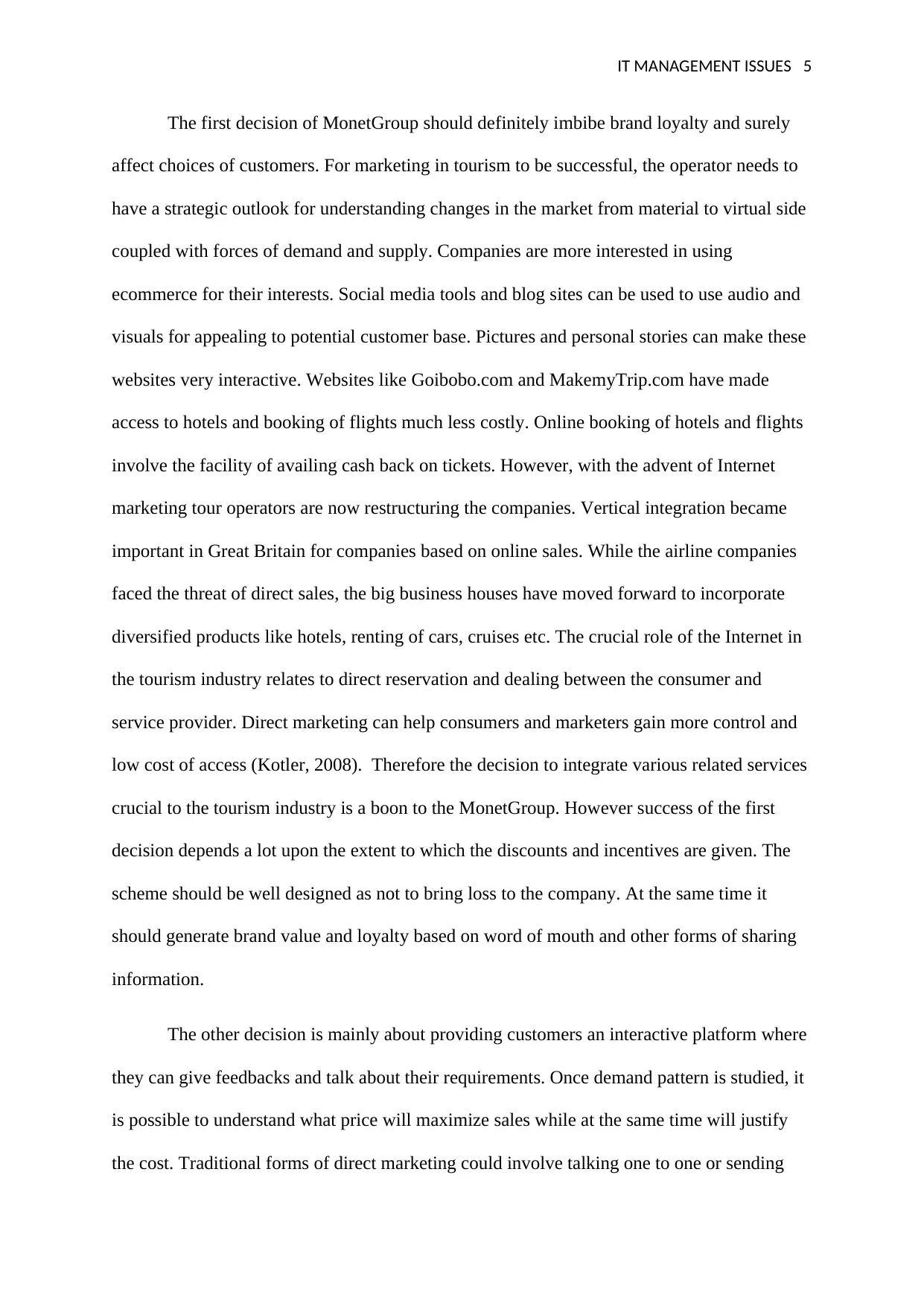
IT MANAGEMENT ISSUES 5
The first decision of MonetGroup should definitely imbibe brand loyalty and surely
affect choices of customers. For marketing in tourism to be successful, the operator needs to
have a strategic outlook for understanding changes in the market from material to virtual side
coupled with forces of demand and supply. Companies are more interested in using
ecommerce for their interests. Social media tools and blog sites can be used to use audio and
visuals for appealing to potential customer base. Pictures and personal stories can make these
websites very interactive. Websites like Goibobo.com and MakemyTrip.com have made
access to hotels and booking of flights much less costly. Online booking of hotels and flights
involve the facility of availing cash back on tickets. However, with the advent of Internet
marketing tour operators are now restructuring the companies. Vertical integration became
important in Great Britain for companies based on online sales. While the airline companies
faced the threat of direct sales, the big business houses have moved forward to incorporate
diversified products like hotels, renting of cars, cruises etc. The crucial role of the Internet in
the tourism industry relates to direct reservation and dealing between the consumer and
service provider. Direct marketing can help consumers and marketers gain more control and
low cost of access (Kotler, 2008). Therefore the decision to integrate various related services
crucial to the tourism industry is a boon to the MonetGroup. However success of the first
decision depends a lot upon the extent to which the discounts and incentives are given. The
scheme should be well designed as not to bring loss to the company. At the same time it
should generate brand value and loyalty based on word of mouth and other forms of sharing
information.
The other decision is mainly about providing customers an interactive platform where
they can give feedbacks and talk about their requirements. Once demand pattern is studied, it
is possible to understand what price will maximize sales while at the same time will justify
the cost. Traditional forms of direct marketing could involve talking one to one or sending
The first decision of MonetGroup should definitely imbibe brand loyalty and surely
affect choices of customers. For marketing in tourism to be successful, the operator needs to
have a strategic outlook for understanding changes in the market from material to virtual side
coupled with forces of demand and supply. Companies are more interested in using
ecommerce for their interests. Social media tools and blog sites can be used to use audio and
visuals for appealing to potential customer base. Pictures and personal stories can make these
websites very interactive. Websites like Goibobo.com and MakemyTrip.com have made
access to hotels and booking of flights much less costly. Online booking of hotels and flights
involve the facility of availing cash back on tickets. However, with the advent of Internet
marketing tour operators are now restructuring the companies. Vertical integration became
important in Great Britain for companies based on online sales. While the airline companies
faced the threat of direct sales, the big business houses have moved forward to incorporate
diversified products like hotels, renting of cars, cruises etc. The crucial role of the Internet in
the tourism industry relates to direct reservation and dealing between the consumer and
service provider. Direct marketing can help consumers and marketers gain more control and
low cost of access (Kotler, 2008). Therefore the decision to integrate various related services
crucial to the tourism industry is a boon to the MonetGroup. However success of the first
decision depends a lot upon the extent to which the discounts and incentives are given. The
scheme should be well designed as not to bring loss to the company. At the same time it
should generate brand value and loyalty based on word of mouth and other forms of sharing
information.
The other decision is mainly about providing customers an interactive platform where
they can give feedbacks and talk about their requirements. Once demand pattern is studied, it
is possible to understand what price will maximize sales while at the same time will justify
the cost. Traditional forms of direct marketing could involve talking one to one or sending
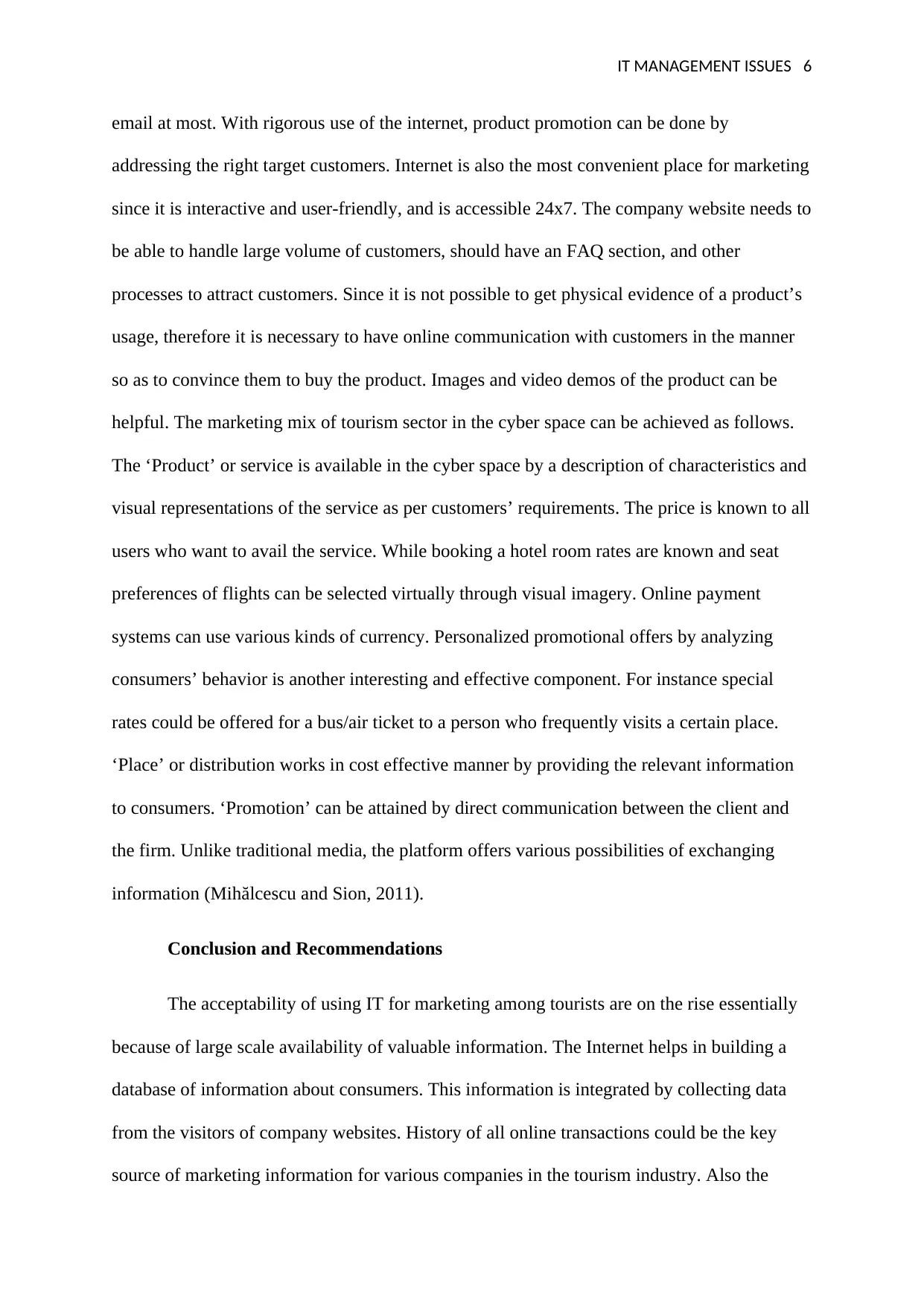
IT MANAGEMENT ISSUES 6
email at most. With rigorous use of the internet, product promotion can be done by
addressing the right target customers. Internet is also the most convenient place for marketing
since it is interactive and user-friendly, and is accessible 24x7. The company website needs to
be able to handle large volume of customers, should have an FAQ section, and other
processes to attract customers. Since it is not possible to get physical evidence of a product’s
usage, therefore it is necessary to have online communication with customers in the manner
so as to convince them to buy the product. Images and video demos of the product can be
helpful. The marketing mix of tourism sector in the cyber space can be achieved as follows.
The ‘Product’ or service is available in the cyber space by a description of characteristics and
visual representations of the service as per customers’ requirements. The price is known to all
users who want to avail the service. While booking a hotel room rates are known and seat
preferences of flights can be selected virtually through visual imagery. Online payment
systems can use various kinds of currency. Personalized promotional offers by analyzing
consumers’ behavior is another interesting and effective component. For instance special
rates could be offered for a bus/air ticket to a person who frequently visits a certain place.
‘Place’ or distribution works in cost effective manner by providing the relevant information
to consumers. ‘Promotion’ can be attained by direct communication between the client and
the firm. Unlike traditional media, the platform offers various possibilities of exchanging
information (Mihălcescu and Sion, 2011).
Conclusion and Recommendations
The acceptability of using IT for marketing among tourists are on the rise essentially
because of large scale availability of valuable information. The Internet helps in building a
database of information about consumers. This information is integrated by collecting data
from the visitors of company websites. History of all online transactions could be the key
source of marketing information for various companies in the tourism industry. Also the
email at most. With rigorous use of the internet, product promotion can be done by
addressing the right target customers. Internet is also the most convenient place for marketing
since it is interactive and user-friendly, and is accessible 24x7. The company website needs to
be able to handle large volume of customers, should have an FAQ section, and other
processes to attract customers. Since it is not possible to get physical evidence of a product’s
usage, therefore it is necessary to have online communication with customers in the manner
so as to convince them to buy the product. Images and video demos of the product can be
helpful. The marketing mix of tourism sector in the cyber space can be achieved as follows.
The ‘Product’ or service is available in the cyber space by a description of characteristics and
visual representations of the service as per customers’ requirements. The price is known to all
users who want to avail the service. While booking a hotel room rates are known and seat
preferences of flights can be selected virtually through visual imagery. Online payment
systems can use various kinds of currency. Personalized promotional offers by analyzing
consumers’ behavior is another interesting and effective component. For instance special
rates could be offered for a bus/air ticket to a person who frequently visits a certain place.
‘Place’ or distribution works in cost effective manner by providing the relevant information
to consumers. ‘Promotion’ can be attained by direct communication between the client and
the firm. Unlike traditional media, the platform offers various possibilities of exchanging
information (Mihălcescu and Sion, 2011).
Conclusion and Recommendations
The acceptability of using IT for marketing among tourists are on the rise essentially
because of large scale availability of valuable information. The Internet helps in building a
database of information about consumers. This information is integrated by collecting data
from the visitors of company websites. History of all online transactions could be the key
source of marketing information for various companies in the tourism industry. Also the
⊘ This is a preview!⊘
Do you want full access?
Subscribe today to unlock all pages.

Trusted by 1+ million students worldwide
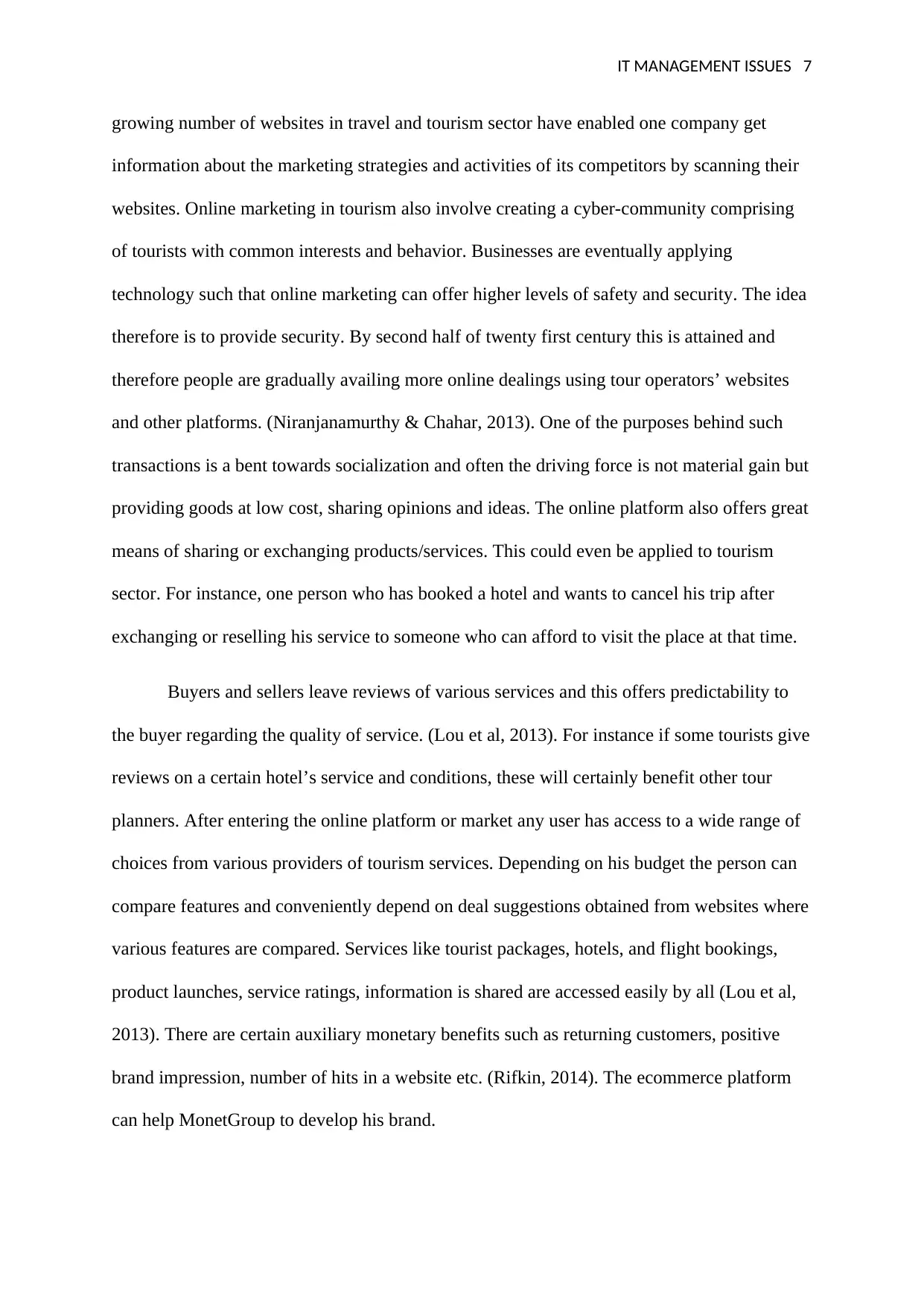
IT MANAGEMENT ISSUES 7
growing number of websites in travel and tourism sector have enabled one company get
information about the marketing strategies and activities of its competitors by scanning their
websites. Online marketing in tourism also involve creating a cyber-community comprising
of tourists with common interests and behavior. Businesses are eventually applying
technology such that online marketing can offer higher levels of safety and security. The idea
therefore is to provide security. By second half of twenty first century this is attained and
therefore people are gradually availing more online dealings using tour operators’ websites
and other platforms. (Niranjanamurthy & Chahar, 2013). One of the purposes behind such
transactions is a bent towards socialization and often the driving force is not material gain but
providing goods at low cost, sharing opinions and ideas. The online platform also offers great
means of sharing or exchanging products/services. This could even be applied to tourism
sector. For instance, one person who has booked a hotel and wants to cancel his trip after
exchanging or reselling his service to someone who can afford to visit the place at that time.
Buyers and sellers leave reviews of various services and this offers predictability to
the buyer regarding the quality of service. (Lou et al, 2013). For instance if some tourists give
reviews on a certain hotel’s service and conditions, these will certainly benefit other tour
planners. After entering the online platform or market any user has access to a wide range of
choices from various providers of tourism services. Depending on his budget the person can
compare features and conveniently depend on deal suggestions obtained from websites where
various features are compared. Services like tourist packages, hotels, and flight bookings,
product launches, service ratings, information is shared are accessed easily by all (Lou et al,
2013). There are certain auxiliary monetary benefits such as returning customers, positive
brand impression, number of hits in a website etc. (Rifkin, 2014). The ecommerce platform
can help MonetGroup to develop his brand.
growing number of websites in travel and tourism sector have enabled one company get
information about the marketing strategies and activities of its competitors by scanning their
websites. Online marketing in tourism also involve creating a cyber-community comprising
of tourists with common interests and behavior. Businesses are eventually applying
technology such that online marketing can offer higher levels of safety and security. The idea
therefore is to provide security. By second half of twenty first century this is attained and
therefore people are gradually availing more online dealings using tour operators’ websites
and other platforms. (Niranjanamurthy & Chahar, 2013). One of the purposes behind such
transactions is a bent towards socialization and often the driving force is not material gain but
providing goods at low cost, sharing opinions and ideas. The online platform also offers great
means of sharing or exchanging products/services. This could even be applied to tourism
sector. For instance, one person who has booked a hotel and wants to cancel his trip after
exchanging or reselling his service to someone who can afford to visit the place at that time.
Buyers and sellers leave reviews of various services and this offers predictability to
the buyer regarding the quality of service. (Lou et al, 2013). For instance if some tourists give
reviews on a certain hotel’s service and conditions, these will certainly benefit other tour
planners. After entering the online platform or market any user has access to a wide range of
choices from various providers of tourism services. Depending on his budget the person can
compare features and conveniently depend on deal suggestions obtained from websites where
various features are compared. Services like tourist packages, hotels, and flight bookings,
product launches, service ratings, information is shared are accessed easily by all (Lou et al,
2013). There are certain auxiliary monetary benefits such as returning customers, positive
brand impression, number of hits in a website etc. (Rifkin, 2014). The ecommerce platform
can help MonetGroup to develop his brand.
Paraphrase This Document
Need a fresh take? Get an instant paraphrase of this document with our AI Paraphraser
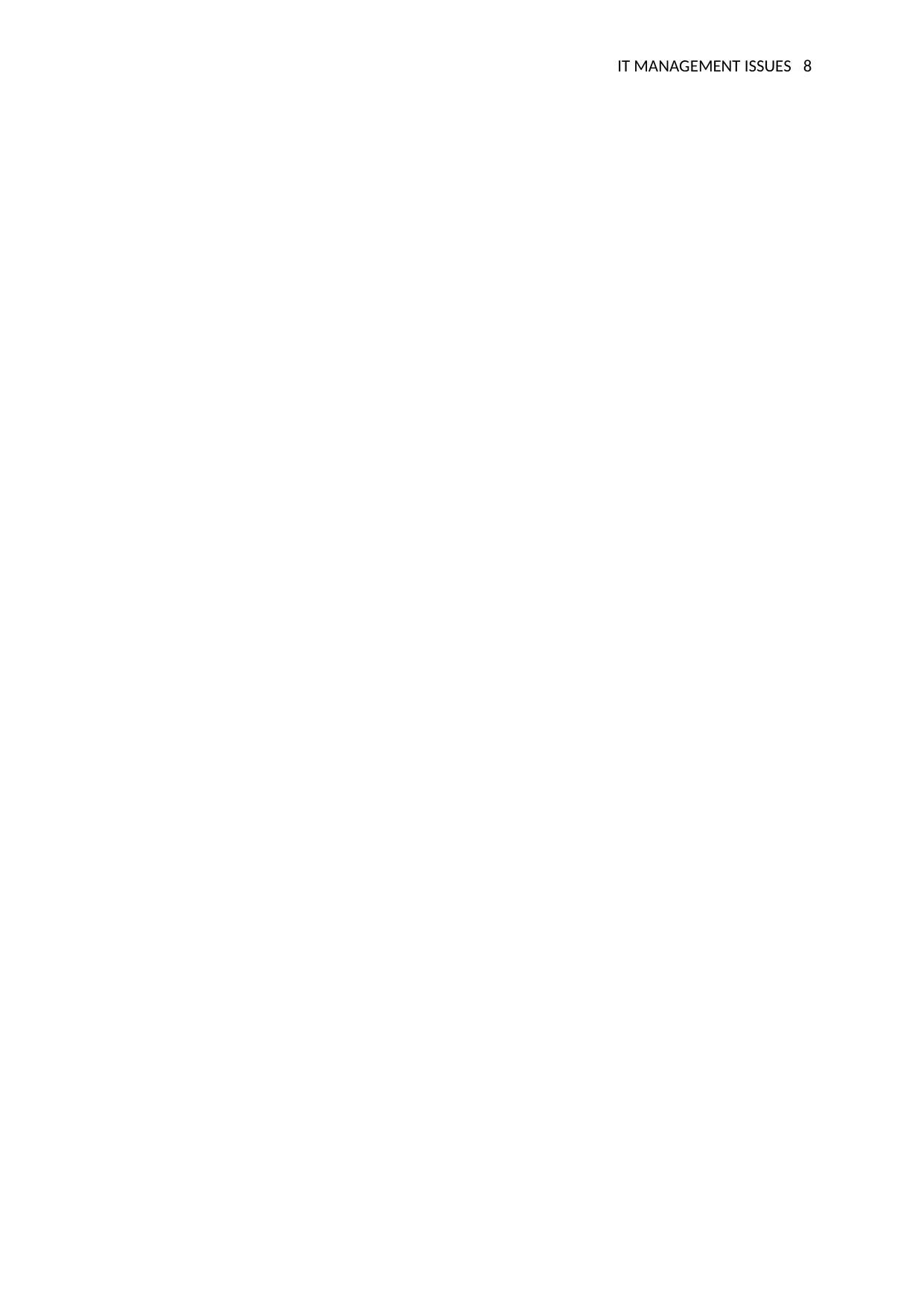
IT MANAGEMENT ISSUES 8
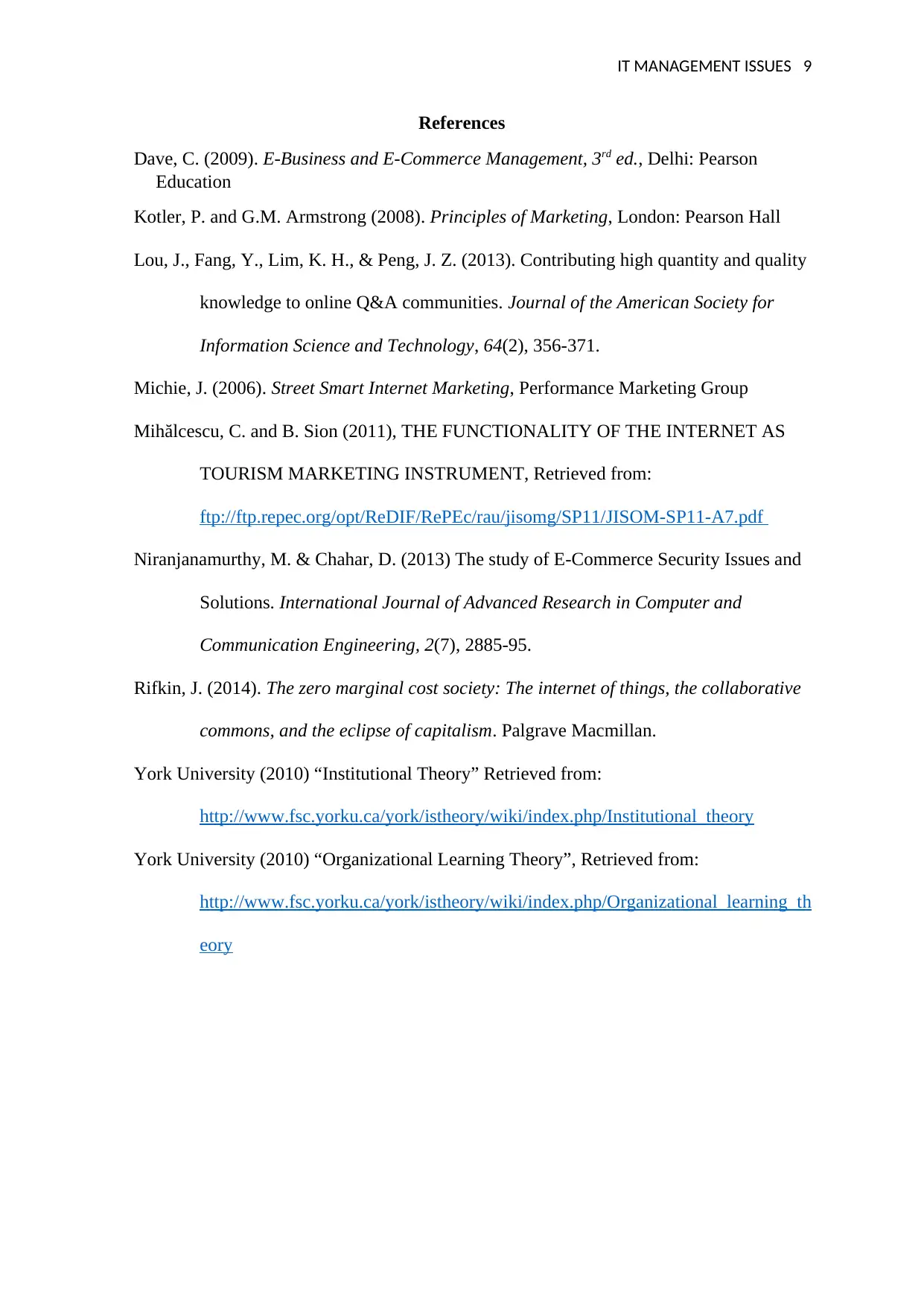
IT MANAGEMENT ISSUES 9
References
Dave, C. (2009). E-Business and E-Commerce Management, 3rd ed., Delhi: Pearson
Education
Kotler, P. and G.M. Armstrong (2008). Principles of Marketing, London: Pearson Hall
Lou, J., Fang, Y., Lim, K. H., & Peng, J. Z. (2013). Contributing high quantity and quality
knowledge to online Q&A communities. Journal of the American Society for
Information Science and Technology, 64(2), 356-371.
Michie, J. (2006). Street Smart Internet Marketing, Performance Marketing Group
Mihălcescu, C. and B. Sion (2011), THE FUNCTIONALITY OF THE INTERNET AS
TOURISM MARKETING INSTRUMENT, Retrieved from:
ftp://ftp.repec.org/opt/ReDIF/RePEc/rau/jisomg/SP11/JISOM-SP11-A7.pdf
Niranjanamurthy, M. & Chahar, D. (2013) The study of E-Commerce Security Issues and
Solutions. International Journal of Advanced Research in Computer and
Communication Engineering, 2(7), 2885-95.
Rifkin, J. (2014). The zero marginal cost society: The internet of things, the collaborative
commons, and the eclipse of capitalism. Palgrave Macmillan.
York University (2010) “Institutional Theory” Retrieved from:
http://www.fsc.yorku.ca/york/istheory/wiki/index.php/Institutional_theory
York University (2010) “Organizational Learning Theory”, Retrieved from:
http://www.fsc.yorku.ca/york/istheory/wiki/index.php/Organizational_learning_th
eory
References
Dave, C. (2009). E-Business and E-Commerce Management, 3rd ed., Delhi: Pearson
Education
Kotler, P. and G.M. Armstrong (2008). Principles of Marketing, London: Pearson Hall
Lou, J., Fang, Y., Lim, K. H., & Peng, J. Z. (2013). Contributing high quantity and quality
knowledge to online Q&A communities. Journal of the American Society for
Information Science and Technology, 64(2), 356-371.
Michie, J. (2006). Street Smart Internet Marketing, Performance Marketing Group
Mihălcescu, C. and B. Sion (2011), THE FUNCTIONALITY OF THE INTERNET AS
TOURISM MARKETING INSTRUMENT, Retrieved from:
ftp://ftp.repec.org/opt/ReDIF/RePEc/rau/jisomg/SP11/JISOM-SP11-A7.pdf
Niranjanamurthy, M. & Chahar, D. (2013) The study of E-Commerce Security Issues and
Solutions. International Journal of Advanced Research in Computer and
Communication Engineering, 2(7), 2885-95.
Rifkin, J. (2014). The zero marginal cost society: The internet of things, the collaborative
commons, and the eclipse of capitalism. Palgrave Macmillan.
York University (2010) “Institutional Theory” Retrieved from:
http://www.fsc.yorku.ca/york/istheory/wiki/index.php/Institutional_theory
York University (2010) “Organizational Learning Theory”, Retrieved from:
http://www.fsc.yorku.ca/york/istheory/wiki/index.php/Organizational_learning_th
eory
⊘ This is a preview!⊘
Do you want full access?
Subscribe today to unlock all pages.

Trusted by 1+ million students worldwide
1 out of 9
Related Documents
Your All-in-One AI-Powered Toolkit for Academic Success.
+13062052269
info@desklib.com
Available 24*7 on WhatsApp / Email
![[object Object]](/_next/static/media/star-bottom.7253800d.svg)
Unlock your academic potential
Copyright © 2020–2025 A2Z Services. All Rights Reserved. Developed and managed by ZUCOL.





